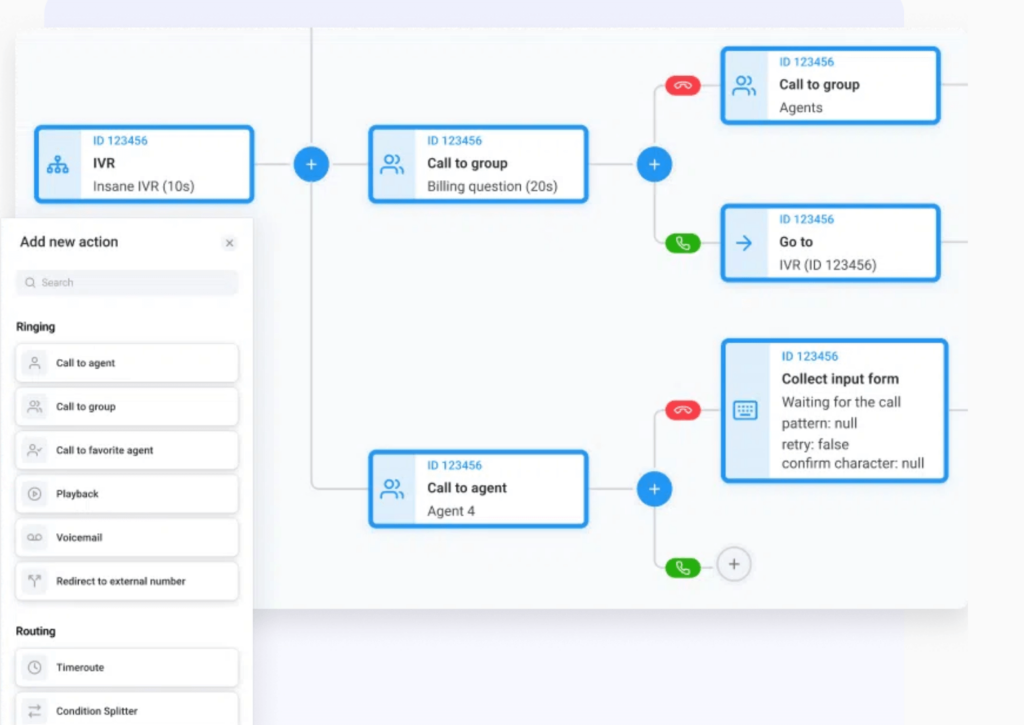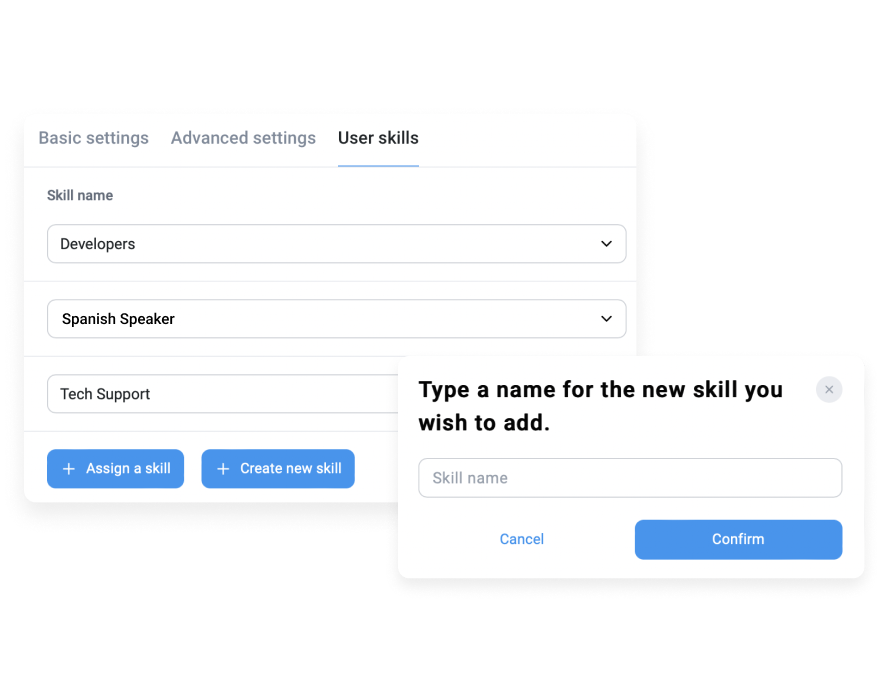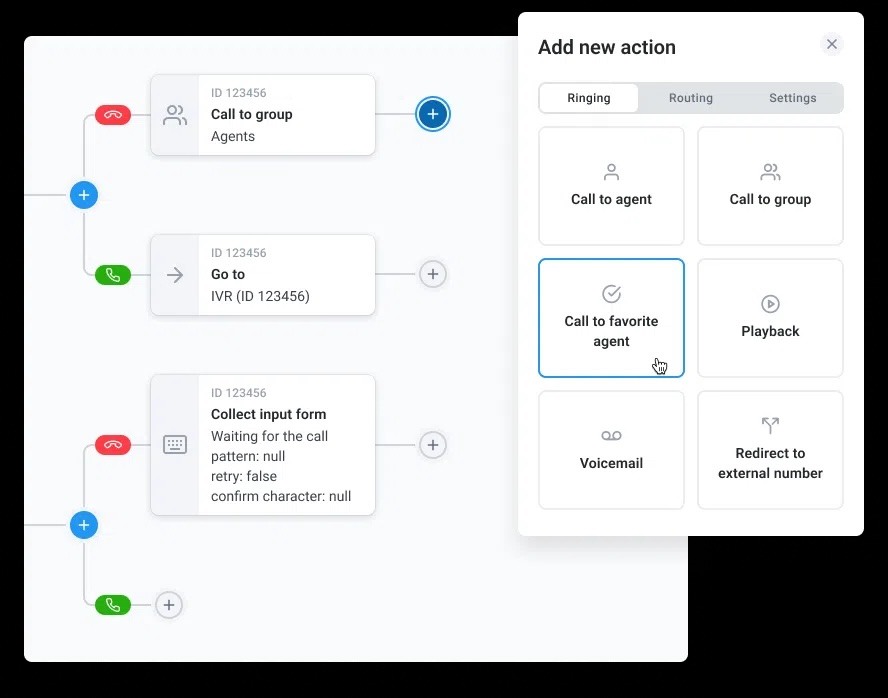IVR in Banking: A Guide For Ops, Sales, and IT Managers

At 3 AM on a Tuesday—while Sarah Chen’s trading team in Singapore prepares for market open, John Miller in Ohio checks his transaction history, and Maria Rodriguez in California manages her bill payments through her bank’s IVR system.
None of these people will ever meet.
None of them will ever visit your physical branch.
And none of them will ever have to wait for standard banking hours to complete their tasks.
Welcome to the new invisible shift in the banking sector. Behind these seamless global transactions sits a technology that most bankers misunderstand, many customers secretly prefer, and virtually every CFO wishes they’d implemented sooner.
Enter: Interactive Voice Response (IVR) systems. IVR offers a 5x improvement in customer satisfaction and issue resolution, while reducing live-agent calls by more than 10%.*
The banks winning with IVR aren’t the ones with the biggest budgets or the most advanced phone system structure. They’re the ones who understand IVR can help banks serve, scale, and succeed in a world where the phrase “banking hours” has lost all meaning.
This guide will show you what aspects of IVR actually matter for your role, whether you’re in operations, sales, or IT. You’ll understand the history and benefits of IVR, as well as key use cases and best practices to implement IVR in your banking system.
Key Takeaways:
- IVR helps reduce call abandonment and automates 90% of routine banking queries.*
- CloudTalk’s Smart IVR and AI features can transform your bank’s customer service from 9-5 to 24/7.
- It’s crucial to implement best practices for user-friendly IVR menus that actually boost customer satisfaction.
Reduce average call duration by as much as 40%
What is IVR in Banking?
Interactive Voice Response (IVR) is an automated business telephony system that interacts with callers through voice input or keypad selections.
In banking, it lets customers perform financial transactions and access account information independently, without human intervention. The system processes incoming calls using a combination of voice recognition technology, pre-recorded messages, and touch-tone keypad inputs to route calls, authenticate users, and complete service requests.

History of IVR
Imagine calling a bank in the 1960s. You’d wait in long queues, speak with a receptionist, and hope they could transfer you to the right department. Fast forward to today, and IVR systems handle millions of banking queries instantly, reshaping how customers interact with financial institutions.
Here’s a short breakdown of the history of IVR:
- 1936 – Bell Labs develops the first speech synthesis system, laying the groundwork for future IVR technology.
- 1962 – IBM introduces Shoebox, an early speech recognition machine that could understand 16 spoken words and digits.
- 1970s – The first true IVR systems emerge, leveraging early speech recognition and touchtone (DTMF) technology, allowing callers to interact with automated systems using keypads.
- 1980s – IVR adoption grows as computing power increases, making voice-driven automation more accessible for businesses.
- 1990s – IVR becomes mainstream in customer service, with improved speech recognition and integration with databases and call centers.
- 2000s – AI-driven IVR and natural language processing (NLP) begin enhancing user experiences, reducing reliance on rigid menu structures.
- 2010s–Present – Cloud-based IVR, AI chatbots, and omnichannel customer service integrate with IVR systems, making them more flexible and efficient.
Now that you know how IVR was developed, let’s explore some benefits.
Benefits of IVR in Banking
Three months into your role as Head of Digital Banking, and the numbers are in front of you: 65% of customers abandon calls during peak hours; your best agents are burning out handling password resets; your competitors are advertising “24/7 intelligent banking” while your bank employees struggle with 9-to-5 coverage.
The board meeting is in two days. You know modernizing your IVR system is the answer, but convincing stakeholders to move beyond their “press 1 for English” comfort zone feels like pushing water uphill. So, you prepare your list of benefits, including:
1. Enhanced Customer Experience
Modern IVR systems handle routine inquiries in real time, 24/7. No more abandoned calls, no more frustrated customers, just service that never sleeps.
2. Operational Costs Savings
Your back-of-envelope calculations show that automating routine queries could result in a 90% containment rate. Let the machines handle the password resets and balance checks, while your team focuses on what they do best: Building relationships and solving complex problems.
3. Intelligent Call Management
Just last week, a major corporate client bounced between three departments before reaching the right team. With intelligent IVR, they would have been routed correctly from the start, their account history and preferences instantly recognized. Market volatility or end-of-quarter rushes? The system scales automatically, maintaining order when you need it most.
4. Data-Driven Insights
Every customer interaction becomes a gold mine of insights. What triggers escalation to human agents? Where are the friction points in your customer journey? Modern IVR offers data driven insights necessary for continuous improvement.
5. Personalization at Scale
When your system recognizes a regular forex trader or a business loan applicant, it can anticipate their needs. “Welcome back, Mr. Song” feels more personalized than “Please enter your account number.” Every interaction becomes an opportunity to show customers you know them, value them, and understand their banking habits.
6. Future-Ready Operations
The best part? As your institution grows, your IVR system grows with you. New branch opening in Dallas? International expansion into Asian markets? Your customer support infrastructure is ready before your first new customer calls. No more scrambling to hire and train agents for every new initiative—just smooth, scalable growth.
Key Use Cases of IVR in the Banking Industry
While the benefits of IVR are clear—your retail banking head wants proof it can handle complex transactions, compliance is nervous about authentication protocols, and somewhere in the world, a customer is trying to dispute a charge.
Looking at the specific use cases, you begin to map out how modern IVR could transform each corner of your operation:
Automating Routine Banking Services Tasks
A customer wakes up at midnight wondering about their account balance. Instead of waiting for your contact center, they get an answer in seconds.
When IVR handles these high-volume, low-complexity tasks, your agents can focus on what humans do best: Solving complex problems, building relationships, and handling sensitive financial discussions that require empathy and expertise.
Enhancing Customer Authentication and Security
IVR analyzes voice patterns, verifies PINs, and sends one-time passwords to registered devices for multi-factor authentication. All this happens in seconds, without the frustration of repeating information to multiple agents.
While customers interact with the system, it’s constantly communicating with your backend security infrastructure. Unusual patterns? Flagged instantly. Attempting bill payments from an unexpected location? Additional notifications triggered automatically. Basically, you have a digital security guard who never sleeps, never gets distracted, and never makes exceptions to the protocol—because one compromised account is one too many.
Loan and Credit Card Application Status Updates
Modern IVR transforms the black box of loan processing into a transparent journey. Instead of playing phone tag with officers during business hours, applicants can check their status anytime—whether it’s a mortgage application or a business loan entering the final review stage. Each status check provides clear, real-time updates.
This frees up time for your loan officers who can now focus on moving applications forward rather than explaining where they’re stuck. The result? Faster processing times, fewer anxious calls, and customers who feel in control of their financial future.
Supporting Multi-Language Customer Service
Modern IVR systems eliminate cultural disconnects from the first “Hello.” Whether it’s Mandarin for your growing Asian customer base, Spanish for your expanding Southwest presence, or Arabic for your international banking clients, the system adapts instantly to each customer’s preferred language. No more awkward transfers, no more lost-in-translation moments—just culturally attuned service that makes every customer feel valued.
Disaster Recovery and Crisis Management
3:15 PM on a Friday: Your mobile banking app crashes. As panic rises and social media explodes with complaints, your IVR system becomes command central for crisis management.
“We are currently experiencing technical difficulties with our mobile app. Your funds are secure. You can still access your accounts through our web portal at…” The message directs customers to working services, providing estimated resolution times, and even offering callback options once systems are restored. Your IVR becomes the calm, consistent voice keeping customers informed and confident in your ability to handle the crisis.
Pro Tip
Pro tip: ⚡Reach 3x more customers by removing repetitive tasks and assigning automated call campaigns to agents with CloudTalk’s IVR and Power Dialer.
Best Practices For Implementing IVR in the Banking Industry
You’ve convinced the board, secured the budget, and selected your IVR vendor. Now comes the part that keeps you up at night: Implementation. In an industry where a single misrouted call can cost millions and a moment of downtime can shatter customer trust, getting this right is crucial. Here’s your roadmap to successful IVR implementation.
Focus on User-Friendly Design
Your most valuable customer, a CEO who keeps eight-figure deposits with your bank, is trying to authorize an urgent international wire transfer. She has exactly three minutes between board meetings, and your IVR system just asked her to: “listen carefully as our menu options have changed”—for the fourth time this year.
Every extra IVR menu option, every unnecessary prompt, every moment of confusion is a micro-erosion of confidence in your bank. Modern IVR implementation demands a ruthless commitment to simplicity. What could you do instead?
- Map out the phone tree: Consider which departments to include, the extent of the self-service options offered, and at which point callers should be transferred to a live agent.
- Limit options: Limit the number of main menu options to 5 or less. Get straight to the point, using clear, concise, and jargon-free language.
- Understand the consumer: Map your menu structure to how customers think about their needs, not how your bank organizes its departments. A customer doesn’t want to “speak to the retail lending division,” they want to, “check my mortgage application status.”
Pro tip
Pro tip: 💡When writing IVR scripts, remember to say the menu option before the number, not the other way around. For example: “For sales, press 3” not “Press 3 for sales.”
Personalize Through Data Integration
Last week, your star relationship manager spent 20 minutes verifying a high-net-worth client’s identity—only to learn they were calling about a routine transaction. Today, we make sure that never happens again.
Here’s how:
- Smart Recognition: CloudTalk’s CRM integration means your IVR system instantly identifies callers through their phone number, connecting to your customer database to build a complete picture before they speak their first word.
- Caller-Based Routing: When customers call, they’re automatically connected to the right department and agent based on their history, preferences, and needs, with tools like CloudTalk. The system adapts so your customers don’t have to.
- Predictive Service: Why make customers tell you what they need when you already know? If they recently reported a lost card, IVR asks about replacement status. If they just made a large transfer, it offers tracking options first. Your IVR becomes less of a gatekeeper and more of a digital concierge.

The goal isn’t to show off how much you know about your customers—it’s to make banking so effortless through Smart IVR, so they don’t even notice the technology. They should just walk away thinking, “My bank really gets me.”
Conduct Regular Testing and Optimization
IVR should evolve alongside your customers’ needs. Here’s a scenario every banking executive knows too well: A routine check of your call metrics reveals that 40% of customers hang up at the third menu level. Is it the phrasing? The menu structure? The timing? Without systematic testing, you’re just guessing.
- Listen to the data: CloudTalk’s Analytics dashboard reveals exactly where customers struggle in your IVR journey. Track abandon rates, identify common exit points, and analyze the paths that lead to successful resolutions.
- Test, learn, refine: Run A/B tests on menu options, voice prompts, and routing logic. Maybe “check recent transactions” works better than “account activity.” Every small refinement adds up to a smoother banking experience.
- Ask your customers: Integrate quick post-call surveys to gather direct feedback. Was the menu clear? Did you reach the right department? How many attempts did it take to complete your task? Use this feedback to continuously polish your IVR flow.
Ensure Scalability and Compliance
Modern banking demands more than just efficient call handling. CloudTalk’s platform automatically handles volume spikes—whether from market events, month-end rushes, or seasonal peaks. The system scales whether you’re managing 100 calls or 10,000, while ensuring PCI-DSS compliance for payments, GDPR adherence for data protection, standardized authentication protocols, and end-to-end data encryption.
When volume surges, CloudTalk intelligently adapts:
- Ring Groups: Personalize how inbound calls are queued and connected to multiple or all agents to shorten response times.
- VIP Queues: Assign VIP tags to high priority customers so that they skip the queue and reach the right agent instantly.
- Extensions: Import or create custom extensions for agents to make searching and transferring customers efficient and easy.

This means your customers experience the same level of service whether they’re calling during quiet periods or peak times.
Incorporate Omnichannel Support
Modern IVR helps create a seamless conversation across every channel your customer chooses. CloudTalk’s integration tools show what’s possible: When a customer starts with a text message about a suspicious transaction, the system maintains that context when they switch to a voice call. Their history, preferences, and current issues follow them across channels, eliminating the frustration of repetition.
Features powered by artificial intelligence can help make this process simpler. Here’s how:
- Call Flow Designer: Design personalized customer journeys that adapt in real-time. When Mrs. Chen calls about a suspicious transaction, the system recognizes her account history and automatically routes her through the most efficient path – whether that’s self-service or priority connection to the fraud team.
- Call Transfers: When a customer needs to switch departments, their entire conversation history and context moves with them. Your agents can even brief each other before the transfer, ensuring no details get lost in transition.
- Call Recording and Transcription: Every interaction is captured and transcribed, creating a searchable history that follows the customer across channels. When they call back, agents can quickly reference previous conversations, making every interaction more personal and efficient.

From 9-5 Service to 24/7 Excellence with IVR
As you wrap up your presentation deck and gear up for tomorrow’s board meeting, one thing is clear: IVR is shaping the future of customer service—from midnight balance checks to early-morning wire transfers.
Your path to IVR excellence requires focusing on key best practices: User-friendly design, data integration for personalized experiences and continuous testing and optimization. CloudTalk delivers on all these fronts with its comprehensive suite of features—from intelligent call routing and VIP Queues to advanced Analytics and omnichannel support.With CloudTalk’s IVR system, you get more than just automation—you get a partner that understands the demands of modern banking.
Offer 24×7 banking services for your customers
*Sources:
FAQs about IVR in banking
How does IVR enhance customer service in banks?
IVR provides 24/7 self-service options, reducing wait times and allowing customers to perform tasks like checking balances or transferring funds.
Is IVR secure for banking transactions?
Yes, IVR systems use encryption and authentication methods to ensure secure transactions and protect customer information.
What does IVR mean in banking?
IVR (Interactive Voice Response) is an automated phone system that lets customers access banking services using voice commands or keypad inputs.
What is the IVR abbreviation for in banking?
IVR stands for Interactive Voice Response—the automated phone system banks use to handle customer calls and provide self-service options.





















